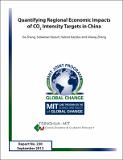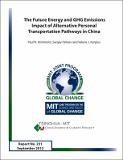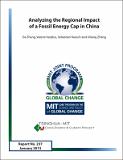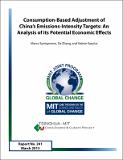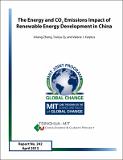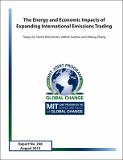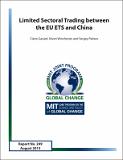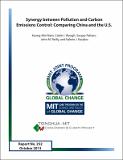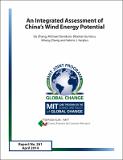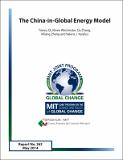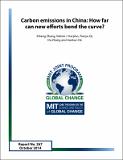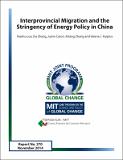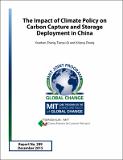Browsing China Energy and Climate Project Reports by Issue Date
Now showing items 1-19 of 19
-
Quantifying Regional Economic Impacts of CO2 Intensity Targets in China
(MIT Joint Program on the Science and Policy of Global Change, 2012-09-01)To address rising energy use and CO2 emissions, China’s leadership has enacted energy and CO2 intensity targets under the Twelfth Five-Year Plan (2011–2015), which are defined at both the national and provincial levels. ... -
The Future Energy and GHG Emissions Impact of Alternative Personal Transportation Pathways in China
(Joint Program on the Science and Policy of Global Change, 2012-10)A major uncertainty in future energy and greenhouse gas (GHG) emissions projections for China is the evolution of demand for personal transportation modes. This paper explores the implications of divergent personal ... -
Will Economic Restructuring in China Reduce Trade-Embodied CO2 Emissions?
(MIT Joint Program on the Science and Policy of Global Change, 2012-10)We calculate CO2 emissions embodied in China’s net exports using a multi-regional input-output database. We find that the majority of China’s export-embodied CO2 is associated with production of machinery and equipment ... -
Climate Co-benefits of Tighter SO2 and NOx Regulations in China
(MIT Joint Program on the Science and Policy of Global Change, 2012-10-01)Air pollution has been recognized as a significant problem in China. In its Twelfth Five Year Plan (FYP), China proposes to reduce SO2 and NOx emissions significantly, and here we investigate the cost of achieving those ... -
Analyzing the Regional Impact of a Fossil Energy Cap in China
(MIT Joint Program on the Science and Policy of Global Change, 2013-01)Decoupling fossil energy demand from economic growth is crucial to China’s sustainable development. In addition to energy and carbon intensity targets enacted under the Twelfth Five-Year Plan (2011–2015), a coal or fossil ... -
Consumption-Based Adjustment of China's Emissions-Intensity Targets: An Analysis of its Potential Economic Effects
(MIT Joint Program on the Science and Policy of Global Change, 2013-03)China’s Twelfth Five-Year Plan (2011–2015) aims to achieve a national carbon intensity reduction of 17% through differentiated targets at the provincial level. Allocating the national target among China’s provinces is ... -
The Energy and CO2 Emissions Impact of Renewable Energy Development in China
(MIT Joint Program on the Science and Policy of Global Change, 2013-04)China’s recently-adopted targets for developing renewable electricity—wind, solar, and biomass—would require expansion on an unprecedented scale in China and relative to existing global installations. An important question ... -
The Energy and Economic Impacts of Expanding International Emissions Trading
(MIT Joint Program, 2013-08-21)Emissions trading systems are recognized as a cost-effective way to facilitate emissions abatement and are expected to play an important role in international cooperation for global climate mitigation. Starting from the ... -
Limited Sectoral Trading between the EU ETS and China
(MIT Joint Program, 2013-08-21)In the negotiations of the United Nations Framework Convention on Climate Change (UNFCCC), new market mechanisms are proposed to involve Non-Annex I countries in the carbon markets developed by Annex I countries, beyond ... -
Synergy between Pollution and Carbon Emissions Control: Comparing China and the U.S.
(MIT Joint Program, 2013-10)We estimate the potential synergy between pollution and climate control in the U.S. and China, summarizing the results as emissions cross-elasticities of control. We set a range of NOx and SO2 targets, and record the ... -
Equity and Emissions Trading in China
(MIT Joint Program on the Science and Policy of Global Change, 2014-02)China has embarked on an ambitious pathway for establishing a national carbon market in the next five to ten years. In this study, we analyze the distributional aspects of a Chinese emissions-trading scheme from ethical, ... -
An Integrated Assessment of China’s Wind Energy Potential
(MIT Joint Program on the Science and Policy of Global Change, 2014-04)Computable general equilibrium (CGE) models seeking to evaluate the impacts of electricity policy face difficulties incorporating detail on the variable nature of renewable energy resources. To improve the accuracy of ... -
The China-in-Global Energy Model
(MIT Joint Program on the Science and Policy of Global Change, 2014-05)The China-in-Global Energy Model (C-GEM) is a global Computable General Equilibrium (CGE) model that captures the interaction of production, consumption and trade among multiple global regions and sectors – including five ... -
Carbon emissions in China: How far can new efforts bend the curve?
(MIT Joint Program on the Science and Policy of Global Change, 2014-10)While China is on track to meet its global climate commitments through 2020, China’s post-2020 CO2 emissions trajectory is highly uncertain, with projections varying widely across studies. Over the past year, the Chinese ... -
Interprovincial Migration and the Stringency of Energy Policy in China
(MIT Joint Program on the Science and Policy of Global Change, 2014-12-02)Interprovincial migration flows involve substantial relocation of people and productive activity, with implications for regional energy use and greenhouse gas emissions. In China, these flows are not explicitly considered ... -
Modeling regional transportation demand in China and the impacts of a national carbon constraint
(2015-01-30)Climate and energy policy in China will have important and uneven impacts on the country’s regionally heterogeneous transport system. In order to simulate these impacts, transport sector detail is added to a multi-sector, ... -
Natural Gas Pricing Reform in China: Getting Closer to a Market System?
(2015-08-31)Recent policy in China targets an increase in the contribution of natural gas to the nation’s energy supply. Historically, China’s natural gas prices have been highly regulated with a goal to protect consumers. The old ... -
Capturing Natural Resource Dynamics in Top-Down Energy‑Economic Equilibrium Models
(2015-10-20)Top-down energy-economic modeling approaches often use deliberately simple techniques to represent heterogeneous resource inputs to production. We show that for some policies, such as feed-in tariffs (FIT) for renewable ... -
The Impact of Climate Policy on Carbon Capture and Storage Deployment in China
(2015-12-28)Carbon capture and storage (CCS) from coal combustion is widely viewed as an important approach for China’s carbon dioxide (CO2) emission mitigation, but the pace of its development is still fairly slow. In addition to the ...

